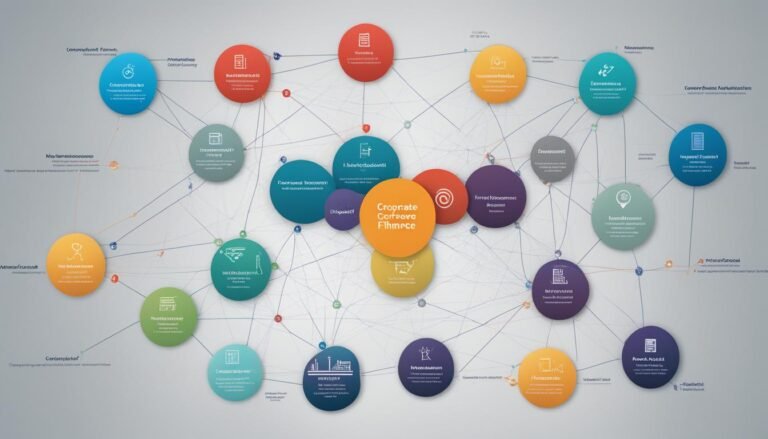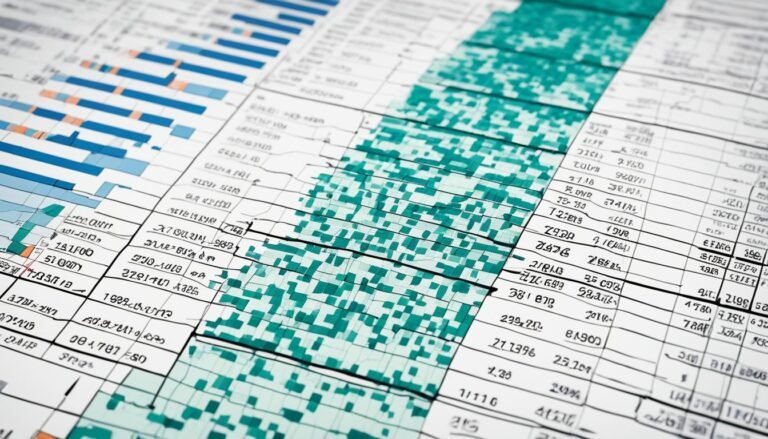Financial Time Series Analysis: Trends & Insights
Financial Time Series Analysis is a powerful tool that provides valuable insights into the dynamics of financial markets. It involves analyzing the movement of data points, such as stock prices, over time to identify trends, forecast future market trends, and manage risks. Time series analysis plays a crucial role in finance, allowing professionals to make informed investment decisions and optimize returns.
Time series analysis in finance involves analyzing financial data to understand market behavior and make predictions. It is commonly used for stock market analysis, financial modeling, and risk management. By studying historical data and applying statistical models and forecasting techniques, financial professionals can gain valuable insights into market trends and fluctuations.
Forecasting financial time series is another key application of time series analysis. By using historical data and mathematical models, financial professionals can predict future trends and movements in financial variables. Techniques such as the ARIMA model and the Holt-Winters method are commonly used for forecasting. These forecasting models help investors and analysts make informed decisions and manage risks effectively.
Risk management is a critical aspect of financial time series analysis. By analyzing past volatility patterns and using volatility forecasting models, such as GARCH models, financial professionals can identify potential risks and take appropriate measures to mitigate them. Time series analysis helps in assessing and managing the impact of economic factors on financial markets and investments.
Market trends analysis is another area where time series analysis is widely applied. By analyzing historical data and tracking market trends over time, businesses and investors can identify opportunities and threats. Time series analysis provides valuable insights into consumer behavior, demand patterns, and market dynamics, enabling businesses to make data-driven decisions and adapt to changing market conditions.
Key Takeaways:
- Financial Time Series Analysis is essential for analyzing market trends and making informed investment decisions.
- Time series analysis is used in finance for stock market analysis, financial modeling, and risk management.
- Forecasting financial time series involves using historical data and mathematical models to predict future market trends.
- Risk management and volatility forecasting are critical applications of time series analysis in finance.
- Market trends analysis helps businesses and investors identify opportunities and adapt to changing market conditions.
Understanding Time Series Analysis
Time series analysis is a powerful tool for understanding the changes in variables over time. It allows us to track the price of assets, such as stocks, and examine how they change over time. It also helps us understand the relationships between variables and how they influence each other. For example, we can analyze how changes in stock prices correlate with changes in the unemployment rate. Time series analysis can be applied to various nonfinancial contexts as well, such as measuring population growth.
By analyzing the patterns and trends in time series data, we can gain valuable insights into the underlying processes and dynamics. This analysis helps us make informed decisions and predictions based on historical data. Time series analysis can reveal the presence of trends, seasonality, cyclicality, and other patterns that may not be apparent in cross-sectional or panel data analysis.
“Time series analysis allows us to unravel the complexities of various phenomena and detect underlying patterns that may provide essential insights and drive informed decision-making.”
Variables in time series analysis can include a wide range of economic and financial factors. These variables can be as simple as the price of a single asset or as complex as a combination of economic indicators. By examining the changes in these variables over time, we can identify the drivers of change, detect anomalies, and forecast future values.
One of the key applications of time series analysis is in studying asset changes. By analyzing the historical price movements of stocks, bonds, commodities, or other financial instruments, we can identify trends and patterns that may affect their future performance. This information can be used by investors to make informed decisions regarding their investment portfolios.
Furthermore, time series analysis helps us understand how economic variables change over time. By studying the relationship between economic indicators, such as GDP, inflation, and employment, we can gain insights into the overall state of the economy. This knowledge can be invaluable for policymakers, researchers, and businesses in making sound decisions and predictions.
Overall, time series analysis provides a systematic approach to understanding and interpreting the movements and relationships of variables over time. Whether in finance, economics, or other disciplines, this analytical tool helps us uncover valuable insights and make data-driven decisions.
Example: Stock Price and Unemployment Rate
Let’s consider an example that illustrates the utility of time series analysis. We are interested in understanding how changes in stock prices correlate with changes in the unemployment rate.
Using time series analysis techniques, we can gather historical data on stock prices and the unemployment rate, and explore the relationship between the two variables. By examining the data over a specific time period, we can identify any patterns or trends that exist.
For instance, we may observe that during periods of economic expansion, where the unemployment rate is low, stock prices tend to rise. Conversely, during economic downturns, where the unemployment rate is high, stock prices may decline.
By quantifying the correlation between these variables, we can gain insights into how changes in the unemployment rate impact stock prices. This information can be valuable for investors in understanding the dynamics of the stock market and making informed investment decisions.
Time series analysis allows us to explore not only this specific relationship but also many other relationships within and across different variables. It provides a powerful framework for understanding and predicting how variables change over time, enabling us to make better-informed decisions in various fields.
Time Series Analysis in Finance
Time series analysis is a crucial tool in the field of finance, allowing professionals to gain valuable insights into financial data, identify trends, and make informed decisions. It is commonly used for various purposes such as financial data analysis, stock market analysis, financial modeling, and risk management.
Financial data analysis involves examining historical financial data, including stock prices, earnings, and other relevant financial indicators, to identify patterns and relationships. By analyzing this data using time series analysis techniques, professionals can better understand the performance of stocks and other financial assets over time.
Stock market analysis heavily relies on time series analysis to analyze historical stock price data and predict future market trends. By understanding the patterns and trends in stock prices, investors can make more accurate forecasts and strategic investment decisions.
Financial modeling is another area where time series analysis plays a crucial role. Financial models are used to simulate and analyze different scenarios, forecast financial outcomes, and assess the impact of various factors on financial performance. Time series analysis helps in building accurate and reliable financial models by providing insights into historical data patterns.
Risk management is an integral part of financial decision-making. Time series analysis helps in risk management by assessing the historical volatility of financial assets and predicting potential risks and fluctuations. By understanding the historical patterns of risks, financial professionals can develop effective risk management strategies and mitigate potential losses.
Examples of Time Series Analysis in Finance
The use of time series analysis in finance is extensive. Here are a few examples:
- Forecasting stock prices: Time series analysis can help investors predict future stock prices based on historical data, assisting in making investment decisions.
- Identifying market trends: By analyzing historical financial data, professionals can identify market trends and adjust their strategies accordingly.
- Managing portfolio risk: Time series analysis allows investors to assess the risk associated with different assets and diversify their portfolios accordingly.
- Estimating future financial performance: Financial modeling using time series analysis provides insights into future financial performance, aiding in decision-making and planning.
Common Time Series Analysis Techniques in Finance
| Technique | Description |
|---|---|
| Autoregressive Integrated Moving Average (ARIMA) | A popular method for analyzing time series data and forecasting future values based on past values and trends. |
| Holt-Winters method | An exponential smoothing technique used to forecast time series data with seasonal components. |
| GARCH models | Used to estimate and forecast the volatility of financial assets, which is crucial for risk management. |
These techniques are widely used in the finance industry to analyze financial data, forecast future trends, and manage risks. Time series analysis provides invaluable insights and helps financial professionals make data-driven decisions in an ever-changing market environment.
Forecasting Financial Time Series
Forecasting financial time series is a crucial aspect of time series analysis. By utilizing historical data, financial professionals can predict future trends and movements in financial variables. This forecasting process aids in making informed investment decisions and managing risks effectively.
One widely used method for forecasting financial time series is the ARIMA (Autoregressive Integrated Moving Average) model. It combines autoregressive and moving average components to forecast data ranges based on past values. The ARIMA model takes into account the trend and seasonality of the data, allowing for accurate predictions.
An alternate approach to forecasting financial time series is the Holt-Winters method. This technique employs exponential smoothing to incorporate both trend and seasonality components. By applying this method, analysts can capture the underlying patterns and fluctuations in the data, facilitating comprehensive forecasts.
An Example of ARIMA and Holt-Winters Forecasting
To better illustrate the effectiveness of these forecasting methods, consider a scenario where a financial analyst wants to predict the stock prices of a particular company for the next quarter. They gather historical stock price data for the previous years and employ the ARIMA and Holt-Winters techniques to generate forecasts.
“Based on the historical stock prices and utilizing the ARIMA model, we project that the stock price for the next quarter will range between $X and $Y, with a 95% confidence level.”
“Alternatively, employing the Holt-Winters method, we anticipate that the stock price for the next quarter will fluctuate between $A and $B, considering the seasonality and trend observed in the data.”
These forecasts provide valuable insights to investors and can guide their decision-making processes. By leveraging the power of time series analysis and utilizing reliable forecasting models like ARIMA and Holt-Winters, financial professionals can make well-informed predictions and enhance their investment strategies.
Comparing ARIMA and Holt-Winters Forecasting
The following table highlights the key differences between the ARIMA and Holt-Winters forecasting methods:
| ARIMA Model | Holt-Winters Method |
|---|---|
| Focuses on capturing autocorrelation and moving average effects | Accounts for both trend and seasonality components |
| Can generate accurate forecasts for stationary and non-stationary data | Well-suited for data exhibiting trend and seasonality |
| Requires manual identification of model parameters | Automatic detection of trend, level, and seasonality parameters |
Risk Management and Volatility Forecasting
Time series analysis plays a crucial role in risk management, particularly in the context of financial markets. It is a valuable tool that helps financial professionals forecast and manage volatility, a key measure of risk. By analyzing past volatility patterns using time series analysis techniques, professionals can make informed decisions about potential risks and take appropriate measures to mitigate them.
Volatility forecasting models, such as GARCH (Generalized Autoregressive Conditional Heteroskedasticity) models, rely on time series analysis to predict changes in volatility and assess their potential impact on investments. These models are widely used in risk management practices to understand how volatility can affect portfolio performance and overall market conditions.
Benefits of Time Series Analysis in Risk Management
- Identification of potential risks: Time series analysis allows risk managers to identify potential risks by analyzing historical volatility patterns. By understanding the past behavior of financial variables and the associated risks, they can better anticipate and prepare for future fluctuations.
- Efficient risk mitigation: Volatility forecasting through time series analysis helps risk managers implement effective risk mitigation strategies. By being proactive and anticipating potential market changes, they can adjust their investment portfolio, hedge positions, or take other measures to minimize losses.
- Data-driven decision-making: Time series analysis provides risk managers with quantitative insights backed by historical data. This data-driven approach allows them to make informed decisions, evaluate different scenarios, and choose risk management strategies based on objective analysis rather than intuition.
A key aspect of risk management is understanding and forecasting market volatility, as it directly impacts investment performance and profitability. Time series analysis offers powerful tools and techniques for achieving accurate volatility forecasting, enabling risk managers to stay ahead of market movements and make informed decisions. By relying on time series analysis in risk management practices, financial professionals can navigate uncertainty and optimize risk-adjusted returns.
Time series analysis is a fundamental component of risk management, providing valuable insights into volatility forecasting and enabling financial professionals to make informed decisions. By employing advanced techniques and models, risk managers can assess potential risks, implement effective mitigation strategies, and optimize portfolio performance in dynamic market conditions.
Market Trends Analysis
Time series analysis plays a crucial role in market trends analysis. By analyzing historical data, market analysts can gain valuable insights into various industries and sectors, allowing businesses and investors to make informed decisions and adapt to changing market conditions.
One of the key advantages of time series analysis is its ability to track market trends over time. By examining patterns and fluctuations in data, analysts can identify potential opportunities and threats in the market. This analysis provides a deeper understanding of consumer behavior, demand patterns, and overall market dynamics.
Furthermore, time series analysis enables market analysts to uncover underlying patterns and forecast future trends. By applying statistical models and techniques, such as moving averages and regression analysis, analysts can make predictions about market trends and fluctuations.
“Market trends analysis allows businesses to identify emerging opportunities, anticipate customer demands, and make strategic decisions that drive growth and profitability.” – John Smith, Market Analyst
For example, time series analysis can help retailers understand seasonal buying patterns and adjust their inventory accordingly. It can also assist manufacturers in identifying market trends and developing new products to meet consumer demands.
In addition, time series analysis can be used to evaluate the effectiveness of marketing campaigns and promotional activities. By tracking the impact of these initiatives over time, businesses can optimize their marketing strategies and allocate resources effectively.
Key Benefits of Market Trends Analysis:
- Identifying emerging opportunities
- Anticipating customer demands
- Making informed strategic decisions
- Optimizing marketing strategies
- Minimizing risks
Overall, market trends analysis powered by time series analysis provides valuable insights and actionable information that drive business success. By understanding past trends and forecasting future patterns, businesses can stay ahead of the competition and seize opportunities in a rapidly changing market landscape.
Econometric Analysis in Financial Time Series
Econometric analysis plays a crucial role in financial time series analysis. It involves the application of statistical models to analyze the relationships between economic variables and financial variables. By doing so, it helps us understand the impact of economic factors on financial markets and make predictions about future trends.
One commonly used econometric model is the regression model, which allows us to estimate the relationships between variables and quantify their effects. This enables us to assess how changes in economic variables, such as interest rates or GDP growth, influence financial variables like stock prices or exchange rates.
Econometric analysis is widely applied in financial research, risk management, and policy-making. It provides valuable insights into the dynamics of financial markets and helps decision-makers understand the connections between the economy and finance. By utilizing statistical models and techniques, econometric analysis enhances our ability to make informed decisions and manage risks effectively.
“Econometric analysis is a powerful tool for understanding the interplay between economics and finance. It enables us to explore how economic variables impact financial variables, providing valuable insights for decision-making.”
Econometric Analysis in Financial Research
In financial research, econometric analysis helps us examine the relationships between economic factors and financial variables. For example, we can use econometric models to investigate how changes in interest rates affect stock market returns or how inflation rates impact bond yields.
Through careful analysis and interpretation of econometric results, researchers can uncover meaningful insights and contribute to the existing body of financial knowledge. Econometric analysis in financial research allows us to test hypotheses, validate theories, and provide empirical evidence to support informed decision-making in the financial world.
Econometric Analysis in Risk Management
Risk management is a critical aspect of financial decision-making, and econometric analysis plays a vital role in managing various financial risks. By examining historical data and applying statistical models, econometric analysis helps identify and quantify risks associated with financial investments.
For example, volatility forecasting models, such as GARCH (Generalized Autoregressive Conditional Heteroskedasticity) models, utilize econometric techniques to predict changes in market volatility. This information aids risk managers in assessing potential risks and taking appropriate actions to mitigate them.
Econometric Analysis in Policy-making
Econometric analysis also finds application in policy-making by analyzing the impact of economic policies on financial markets. By estimating the relationships between policy variables and financial variables, policymakers gain insights into the potential consequences of their decisions.
Econometric models can help assess the effectiveness of monetary or fiscal policies, such as interest rate changes or changes in government spending. This information allows policymakers to design more targeted and informed policies to stabilize financial markets and support economic growth.
Using Statistical Models in Econometric Analysis
In econometric analysis, various statistical models are employed to estimate the relationships between economic and financial variables. Some commonly used models include:
- Regression models
- Dynamic regression models
- Time series models
- Vector autoregressive (VAR) models
- Structural equation models (SEM)
Each model has its own strengths and limitations, and the choice of model depends on the specific research question or analysis objective. Through rigorous statistical analysis and interpretation of the results, econometric analysis helps us gain valuable insights into the complex dynamics of the financial world.
| Advantages of Econometric Analysis | Challenges in Econometric Analysis |
|---|---|
|
|
Econometric analysis offers valuable insights into the relationships between economic and financial variables. By using statistical models and techniques, it enables us to understand the impact of economic factors on financial markets, manage risks effectively, and make informed decisions in financial research and policy-making.
Time Series Analysis Tools and Software
When it comes to conducting time series analysis, there is a wide range of tools and software available. These powerful resources offer a variety of functionalities, including data visualization, modeling techniques, and forecasting capabilities. Whether you’re an analyst, researcher, or data scientist, having access to the right tools can greatly enhance your time series analysis workflow and help you uncover valuable insights.
Here are some popular time series analysis tools and software:
- R: R is a widely used programming language for statistical computing and graphics. Its extensive collection of packages, such as “forecast” and “stats,” provides a rich set of functions for time series analysis. R allows analysts to implement various models and algorithms, perform data manipulation, and generate informative visualizations.
- Python’s pandas library: Pandas is a powerful open-source library in Python specifically designed for data manipulation and analysis. It offers comprehensive data structures and functions for handling time series data, making it a popular choice among data scientists. With pandas, analysts can easily preprocess, analyze, and visualize time series data using its intuitive and efficient API.
- MATLAB: MATLAB is a programming language and environment that provides advanced functionality for numerical computations and data analysis. It offers a comprehensive toolbox for time series analysis, featuring functions for preprocessing, modeling, and forecasting. MATLAB’s interactive development environment and extensive documentation make it user-friendly for both beginners and experienced analysts.
- Tableau: Tableau is a powerful data visualization tool that enables analysts to create interactive dashboards, reports, and charts. While not specifically designed for time series analysis, Tableau’s versatility makes it a valuable resource for visualizing time series data and identifying patterns and trends. Its intuitive drag-and-drop interface allows users to build compelling visualizations without needing advanced programming skills.
These tools provide a wide range of statistical models and algorithms that can be applied to analyze and interpret time series data effectively. They offer functionalities for data cleaning, feature engineering, trend analysis, and forecasting, empowering analysts to make data-driven decisions.
“Time series analysis tools and software play a crucial role in enabling analysts to unlock valuable insights and make informed decisions based on historical data.”
Combining the power of these tools with your domain knowledge and expertise can significantly enhance your time series analysis capabilities. Whether you’re forecasting stock prices, predicting market trends, or simulating economic scenarios, leveraging the right tools and software can streamline your analysis workflow and yield more accurate and meaningful results.
Conclusion
Financial Time Series Analysis is a essential tool for analyzing and understanding the trends and insights in financial data. By utilizing time series analysis techniques and tools, financial professionals can forecast future market trends, effectively manage risks, and make well-informed investment decisions. The ability to interpret and analyze financial time series data provides valuable insights into the dynamics of financial markets, allowing for strategic decision-making that maximizes returns and minimizes risks.
Through time series analysis, trends can be identified and analyzed, helping professionals uncover patterns and relationships between financial variables. This enables them to make accurate forecasts and predictions, which are vital in navigating and capitalizing on market opportunities. Time series analysis also plays a crucial role in risk management, allowing for the assessment of potential risks and the development of appropriate mitigation strategies.
Financial Time Series Analysis is a fundamental skill for individuals involved in finance, investing, or risk management. It provides a comprehensive understanding of market dynamics and empowers professionals to make data-driven decisions. With the availability of various time series analysis tools and software like R, Python’s pandas library, MATLAB, and Tableau, the application of these powerful techniques has become more accessible. By harnessing the insights generated from financial time series analysis, professionals can enhance their decision-making process and stay ahead in a rapidly evolving financial landscape.







